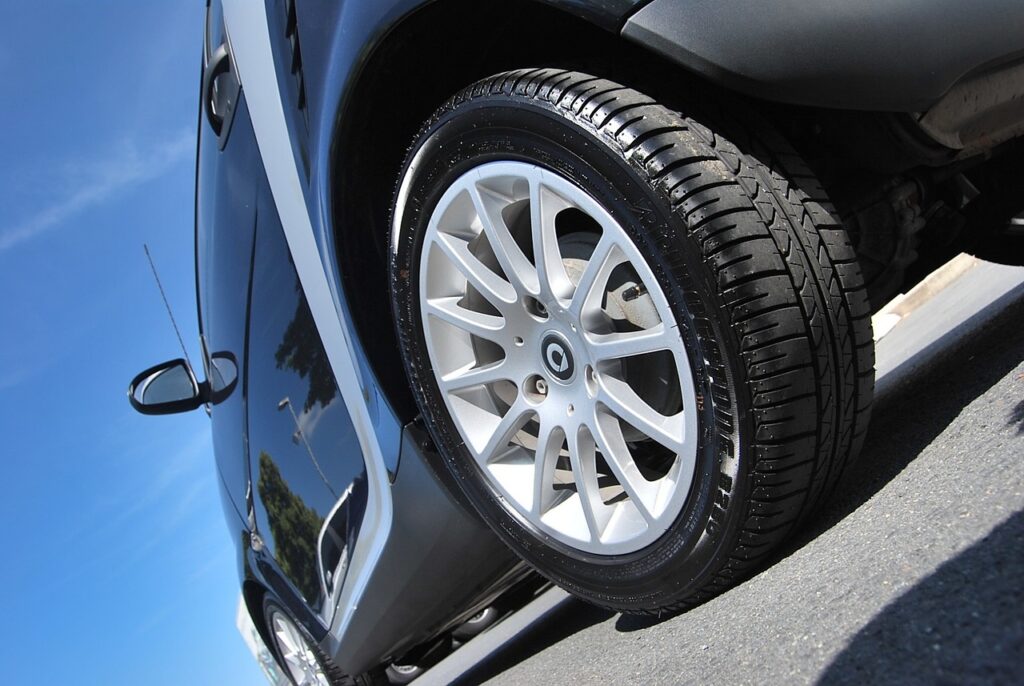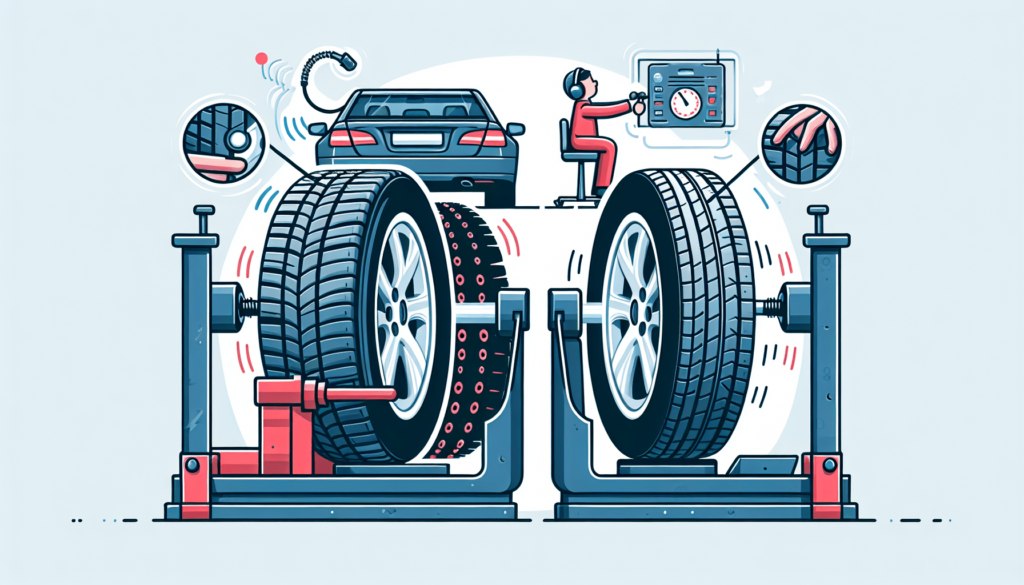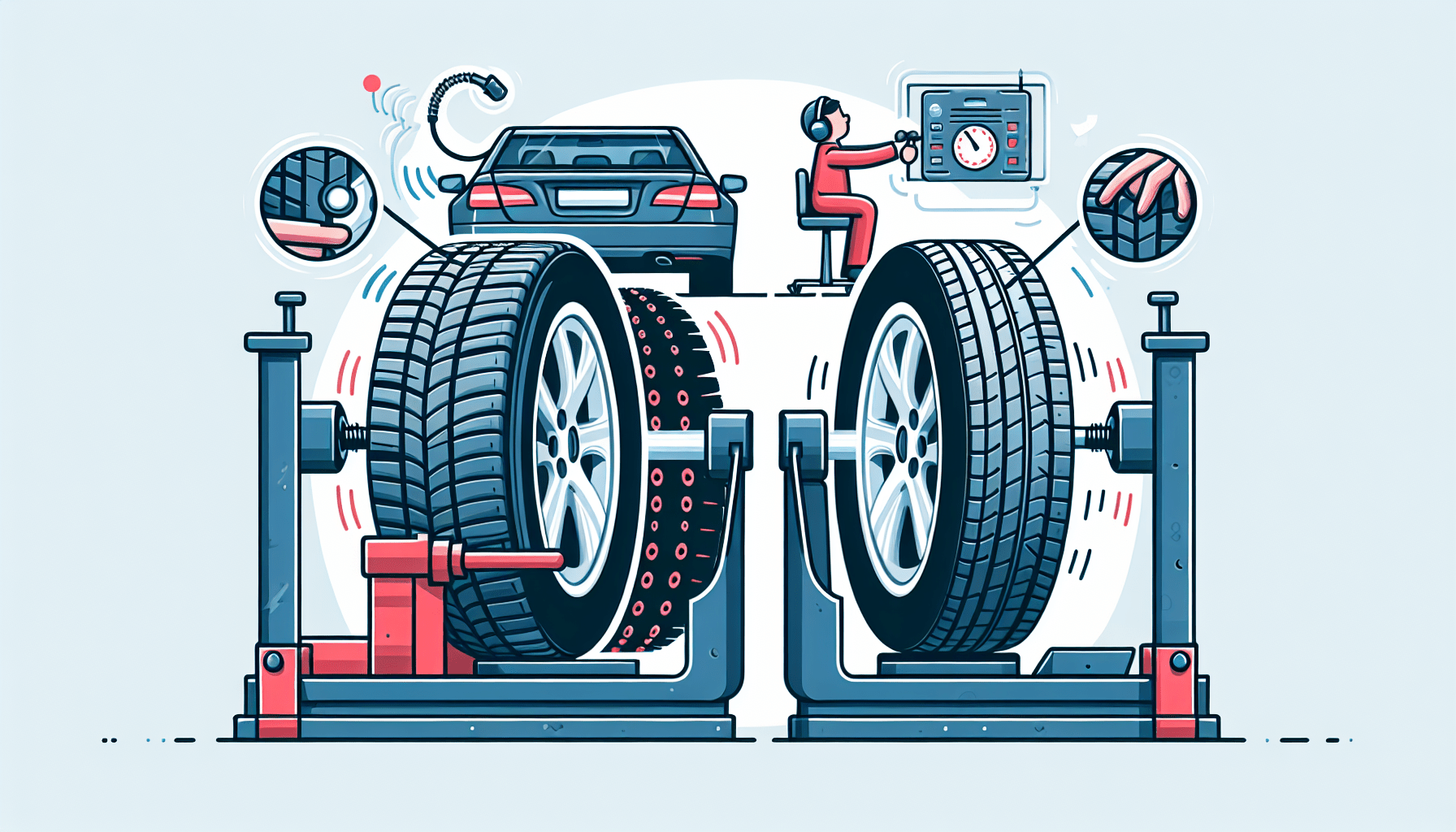Imagine cruising down the road, wind in your hair and your favorite tunes playing on the radio, when suddenly an annoying humming noise disrupts your blissful drive. It’s the dreaded sound of excessive tire noise, and it can quickly turn a pleasant journey into a headache. But fear not, because there might just be a simple solution. The question is, can wheel alignment be the key to silencing those noisy tires? Let’s find out.
Understanding the Causes of Tire Noise
Tire Tread Design
The tread design of a tire plays a crucial role in determining the level of noise it produces. Different tire manufacturers use various tread patterns, which can vary in terms of noise generation. Tread patterns with larger tread blocks or aggressive tread designs tend to produce more noise compared to tires with smaller, more evenly spaced tread blocks. So, when you are choosing new tires, it’s worth considering the tread design in order to minimize potential noise.
Tire Inflation
Proper tire inflation is not only essential for optimal performance and fuel efficiency but also for reducing tire noise. Underinflated tires can create a humming or buzzing sound due to increased contact between the tire and the road surface. On the other hand, overinflated tires can lead to a louder and harsher noise output, as there is less absorption of road irregularities. It’s important to maintain the recommended tire pressure to mitigate unnecessary noise.
Wheel Balance
Another factor that contributes to tire noise is wheel balance. When a wheel is not properly balanced, it can cause vibrations that result in a humming or buzzing noise. This imbalance can occur due to uneven weight distribution on the tire or a bent or damaged wheel. Regular wheel balancing can help minimize these vibrations and reduce unwanted noise.
What is Wheel Alignment?
Definition of Wheel Alignment
Wheel alignment refers to the adjustment of the angles at which the tires make contact with the road. It involves adjusting the suspension components and steering system to ensure that the wheels are parallel to each other and perpendicular to the ground. Proper wheel alignment ensures optimal vehicle performance, handling, and tire longevity.
Three Main Wheel Alignment Parameters
There are three main parameters involved in wheel alignment: camber, caster, and toe. Camber refers to the vertical tilt of the wheel when viewed from the front or rear of the vehicle. Caster refers to the angle of the steering axis when viewed from the side of the vehicle. Toe refers to the direction in which the tires point relative to each other. Achieving the correct alignment for these parameters is crucial for reducing tire noise and ensuring overall vehicle stability.

Effects of Poor Wheel Alignment on Tire Noise
Uneven Tread Wear
One of the most apparent consequences of poor wheel alignment is uneven tire tread wear. Misaligned wheels cause the tires to scrub against the road surface at irregular angles, leading to uneven wear patterns. This uneven tread wear can generate increased tire noise as the compromised tread tries to maintain traction on the road. To avoid excessive tire noise, it’s important to address wheel misalignment promptly.
Increased Rolling Resistance
Misaligned wheels can also contribute to increased rolling resistance, which refers to the force required to keep the tires moving forward. When the wheels are not aligned correctly, they can create additional drag on the tires, making the vehicle work harder to maintain speed. This increased rolling resistance can result in more tire noise, as more effort is required to overcome the resistance caused by misalignment.
Vibration and Noise
Misaligned wheels can cause vibrations that transfer to the steering wheel and throughout the vehicle. These vibrations can lead to an increase in tire noise, especially at higher speeds. As the wheels struggle to maintain stability due to misalignment, the resulting vibrations can create a noticeable hum or rumble. Proper wheel alignment can help minimize these vibrations and reduce unwanted noise.
Can Wheel Alignment Reduce Tire Noise?
Alignment’s Impact on Tread Wear
Proper wheel alignment significantly impacts tire tread wear. When the wheels are aligned correctly, the tires wear evenly. In turn, even tread wear helps maintain a smoother and quieter ride. By reducing the potential for uneven tread wear, wheel alignment plays a vital role in minimizing tire noise.
Alignment’s Effect on Rolling Resistance
Misaligned wheels can increase rolling resistance, resulting in more tire noise. On the contrary, correctly aligned wheels reduce rolling resistance by ensuring optimal contact between the tires and the road surface. Reduced rolling resistance not only promotes fuel efficiency but also helps in reducing tire noise during travel.
Alignment’s Role in Vibration and Noise Reduction
Proper wheel alignment is crucial for minimizing vibrations that can lead to excessive tire noise. By ensuring that the wheels are aligned parallel to each other and perpendicular to the ground, wheel alignment helps eliminate vibrations caused by misalignment. This reduction in vibrations promotes a smoother and quieter ride, making your journey more enjoyable.

Importance of Regular Wheel Alignment
Longevity of Tires
Regular wheel alignment is essential for maintaining the longevity of your tires. When the wheels are aligned correctly, the tires wear evenly, minimizing the risk of premature tire wear. By reducing the chances of uneven tread wear, wheel alignment helps extend the lifespan of your tires, saving you money in the long run.
Improved Safety
Proper wheel alignment is crucial for vehicle safety. Misaligned wheels can affect the handling and stability of your vehicle, compromising your ability to control it effectively. This lack of control poses a safety risk, especially during emergency maneuvers or adverse road conditions. By regularly aligning your wheels, you promote safer driving by ensuring optimal vehicle performance.
Fuel Efficiency
Misaligned wheels can increase rolling resistance, leading to decreased fuel efficiency. When the tires encounter more resistance from the road surface, more energy is required to maintain speed, ultimately resulting in increased fuel consumption. By ensuring proper wheel alignment, you improve fuel efficiency and reduce the environmental impact of your vehicle.
Proper Wheel Alignment Procedures
Inspection of Suspension Components
Before conducting wheel alignment, it’s essential to inspect the suspension components thoroughly. Worn or damaged suspension parts can affect the alignment process and hinder the effectiveness of the alignment adjustments. By ensuring that all suspension components are in good condition, you set a solid foundation for accurate and long-lasting wheel alignment.
Measuring and Adjusting Alignment Parameters
To achieve proper wheel alignment, specialized equipment is used to measure the current alignment parameters accurately. These measurements include camber, caster, and toe angles. Based on the initial readings, adjustments are made to align the wheels correctly according to manufacturer specifications. These adjustments may involve turning adjustment bolts or using shims to bring the wheels into alignment.
Thorough Test Drive
Once the wheel alignment adjustments have been made, it is crucial to conduct a thorough test drive to ensure the alignment is properly adjusted. The test drive allows professionals to assess the alignment’s effectiveness and make any necessary fine-tuning adjustments. By thoroughly testing the vehicle on different road surfaces and speeds, they can ensure that the alignment is optimal for reducing tire noise.

Other Factors Affecting Tire Noise
Tire Type and Quality
Apart from tread design, the type and quality of the tire itself can impact overall noise levels. Some tire manufacturers prioritize noise reduction by incorporating special tread compounds or noise-canceling technologies in their tire designs. Choosing premium tires that prioritize a quiet and comfortable ride can help minimize tire noise.
Road Conditions
The condition of the road surface can have a significant impact on tire noise. Rough, uneven, or poorly maintained roads can contribute to increased tire noise, especially at higher speeds. Smooth and well-maintained roads tend to generate less noise, providing a quieter driving experience. Unfortunately, road conditions are beyond your control, but maintaining proper alignment and tire inflation can still help mitigate the impact of road-induced noise.
Vehicle Maintenance
Proper vehicle maintenance plays a role in reducing tire noise. Regular tire rotations, wheel balancing, and tire inspections can help identify and address potential issues before they escalate. By paying attention to these maintenance tasks, you contribute to overall vehicle performance and reduce the likelihood of excessive tire noise caused by neglect.
Signs of Misaligned Wheels
Uneven Tire Wear
One of the most noticeable signs of misaligned wheels is uneven tire wear. If you observe that the tread on your tires is wearing unevenly, with more wear on one side compared to the other, it may indicate the need for wheel alignment. Uneven tire wear not only affects tire noise but also compromises traction and safety.
Vehicle Pulling to One Side
When your vehicle tends to pull or drift to one side, even when the steering wheel is centered, it could indicate misaligned wheels. Misalignment can cause unequal pressure on the tires, resulting in an imbalanced steering response. If you experience this pulling sensation, it’s essential to have your wheels aligned promptly to ensure optimal vehicle control and safety.
Steering Wheel Vibration
If you notice a noticeable vibration in your steering wheel, particularly at higher speeds, it could be a sign of wheel misalignment. Misaligned wheels can cause the steering wheel to vibrate due to uneven tire wear or the wheels struggling to maintain stability. Addressing the wheel alignment issue can help eliminate this vibration and restore a smoother driving experience.

Professional Wheel Alignment vs. DIY
Benefits of Professional Service
Seeking professional wheel alignment service offers several advantages. Professional alignment technicians have the necessary expertise, experience, and specialized equipment to perform accurate wheel alignments. They can ensure precise adjustments, reducing the risk of future tire noise or handling issues. Additionally, professional service often includes a comprehensive inspection of the suspension system, identifying any other potential issues that may affect alignment or tire performance.
Limitations of DIY Alignment
While DIY alignment kits may be available on the market, it’s important to note their limitations. These kits lack the precision and accuracy of professional equipment, making it difficult to achieve proper alignment. Proper wheel alignment requires intricate adjustments and measurement, which may be challenging for individuals without proper training and experience. Attempting DIY alignment can lead to inaccurate adjustments, potentially causing more harm than good.
Conclusion
Wheel Alignment as a Preventative Measure
Proper wheel alignment is not just a solution for existing tire noise; it also serves as a preventative measure. By regularly aligning your wheels, you can minimize the risk of excessive tire noise due to uneven tread wear, increased rolling resistance, and vibrations. By maintaining optimal alignment, you ensure a quieter and more enjoyable driving experience.
Addressing Misalignment for Quieter Tires
If you’re experiencing excessive tire noise, it’s crucial to address any potential wheel misalignment. Consult a professional wheel alignment service to accurately measure and adjust the alignment parameters. By doing so, you can minimize tire noise, improve tire longevity, enhance safety, and optimize fuel efficiency. Don’t let tire noise become a constant annoyance when proper wheel alignment can provide a serene driving experience.


